机械工程英语第十四单元[40P][238KB]
- 格式:pdf
- 大小:238.95 KB
- 文档页数:40
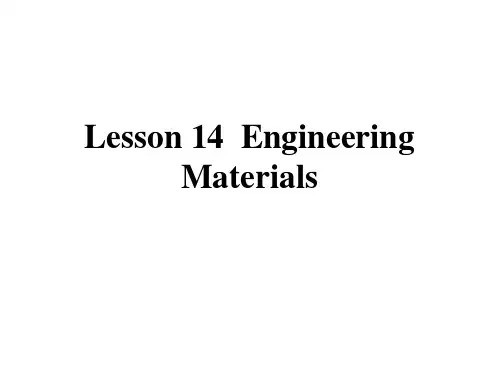
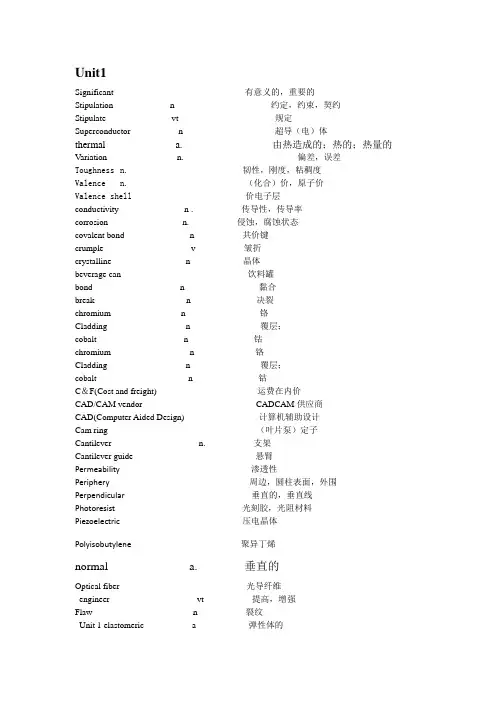
Unit1Significant 有意义的,重要的Stipulation n 约定,约束,契约Stipulate vt 规定Superconductor n 超导(电)体thermal a. 由热造成的;热的;热量的Variation n. 偏差,误差Toughness n. 韧性,刚度,粘稠度Valence n. (化合)价,原子价Valence shell 价电子层conductivity n . 传导性,传导率corrosion n. 侵蚀,腐蚀状态covalent bond n 共价键crumple v 皱折crystalline n 晶体beverage can 饮料罐bond n 黏合break n 决裂chromium n 铬Cladding n 覆层;cobalt n 钴chromium n 铬Cladding n 覆层;cobalt n 钴C&F(Cost and freight) 运费在内价CAD/CAM vendor CADCAM供应商CAD(Computer Aided Design) 计算机辅助设计Cam ring (叶片泵)定子Cantilever n. 支架Cantilever guide 悬臂Permeability 渗透性Periphery 周边,圆柱表面,外围Perpendicular 垂直的,垂直线Photoresist 光刻胶,光阻材料Piezoelectric 压电晶体Polyisobutylene 聚异丁烯normal a. 垂直的Optical fiber 光导纤维engineer vt 提高,增强Flaw n 裂纹Unit 1 elastomeric a 弹性体的Fracture toughness 断裂韧性Free v 释放Fully dense article 充分致密的物件graphite n.. 石墨hob n. 齿轮滚刀,轮毂vt.滚齿hydrophobic a. 恐水的insulator n. 绝缘体,绝热器intermetallic a 金属间的jacket n. 护套intermetallic compounds 金属间化合物Magnesium n. 镁Magnetic a. 有磁性的refractive n. 折射的variation n .偏差,误差dopant n. 掺杂物drawback n. 缺点,障碍ductility n. 韧性,展延性Unit2abrasion n. 磨耗磨损agglomeration n. 结块,凝聚,块alkali n. 碱approximate a. 近似的,大概的critical range 临界范围austempering n 奥氏体回火,等温淬火austenite n 奥氏体brine n 盐水Coalesce v 熔合Coalescence n 合并,接合,联合Cementite n. 渗碳体,炭素体Charcoal n. 木炭Pearlite 珠光体molybdenum n. 【化】泪nicarbing n. 渗碳氮化nitric a. 【化】氮的nitriding v. 渗氮normalizing n. 正火,常化nucleate v. 成核,集结Ore extraction 矿石提炼Single-phase n 【物】单相的Austenite n 【】体spray vt 喷涂resemblance n. 类似,与……相似(to)tempering v. 回火tensile strength 抗拉强度tension n. 张力,弹力Warp v. 变形Whereas conj. 而,其实Trace n. 轨迹,痕迹Full annealing 完全退火immerse vt. 侵入in essence 大体上,本(实)质上key transition 主要的转换quench v./n. 急冷,淬火regardless of 不管,不论warp v. 变形whereas conj .而,其实Resemblance n. 类似,与……相似Scale vt . 改变比例cyanide n. [化]氰化[物] vt. 用氰化物处Decomposition n. 分解还原分析Delta n. 三角形drastically ad. 严重地,猛烈地,急剧地;严格地draw (drew, drawn) v. 扎制Unit3Scrap 残余物,废料nShrinkage 皱缩nSilica 硅石,硅土nSilicate 硅酸脂,硅酸盐n Sillimanite 硅线n Slag 熔渣n Slurry 悬浮液,膏剂n sprue 浇注口n scrap n. 碎片,废料robust a. 结实的Stereo n 立体声音响设备Vendor n. 出售商Vent n. 通气孔v.扎通气孔Verification n. 验证Undercut n. 下挖,凹割:铸件侧面凹部Vaporize v. 汽化align v. 排成一线alignment n. 校直,对准,定心allow for 考虑到,为。
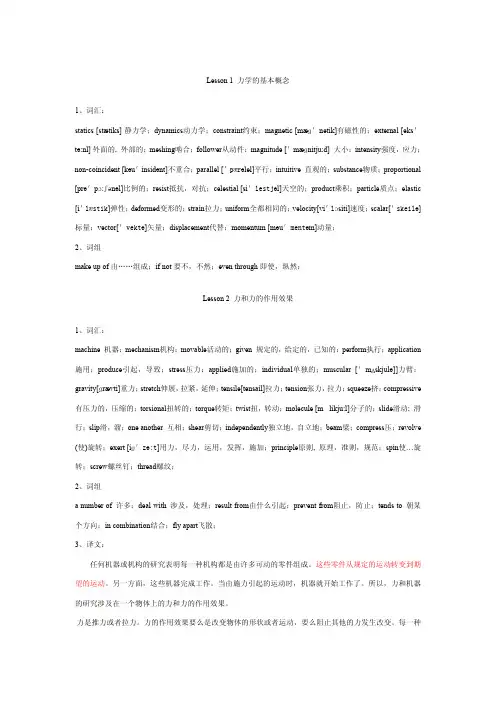
Lesson 1 力学的基本概念1、词汇:statics [stætiks] 静力学;dynamics动力学;constraint约束;magnetic [mæɡ'netik]有磁性的;external [eks'tə:nl] 外面的, 外部的;meshing啮合;follower从动件;magnitude ['mæɡnitju:d] 大小;intensity强度,应力;non-coincident [kəu'insidənt]不重合;parallel ['pærəlel]平行;intuitive 直观的;substance物质;proportional [prə'pɔ:ʃənəl]比例的;resist抵抗,对抗;celestial [si'lestjəl]天空的;product乘积;particle质点;elastic [i'læstik]弹性;deformed变形的;strain拉力;uniform全都相同的;velocity[vi'lɔsiti]速度;scalar['skeilə]标量;vector['vektə]矢量;displacement代替;momentum [məu'mentəm]动量;2、词组make up of由……组成;if not要不,不然;even through即使,纵然;Lesson 2 力和力的作用效果1、词汇:machine 机器;mechanism机构;movable活动的;given 规定的,给定的,已知的;perform执行;application 施用;produce引起,导致;stress压力;applied施加的;individual单独的;muscular ['mʌskjulə]]力臂;gravity[ɡrævti]重力;stretch伸展,拉紧,延伸;tensile[tensail]拉力;tension张力,拉力;squeeze挤;compressive 有压力的,压缩的;torsional扭转的;torque转矩;twist扭,转动;molecule [m likju:l]分子的;slide滑动; 滑行;slip滑,溜;one another 互相;shear剪切;independently独立地,自立地;beam梁;compress压;revolve (使)旋转;exert [iɡ'zə:t]用力,尽力,运用,发挥,施加;principle原则, 原理,准则,规范;spin使…旋转;screw螺丝钉;thread螺纹;2、词组a number of 许多;deal with 涉及,处理;result from由什么引起;prevent from阻止,防止;tends to 朝某个方向;in combination结合;fly apart飞散;3、译文:任何机器或机构的研究表明每一种机构都是由许多可动的零件组成。
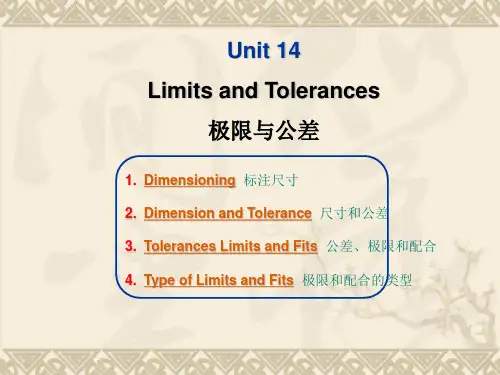
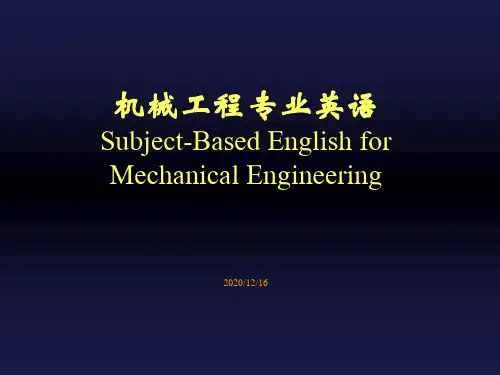
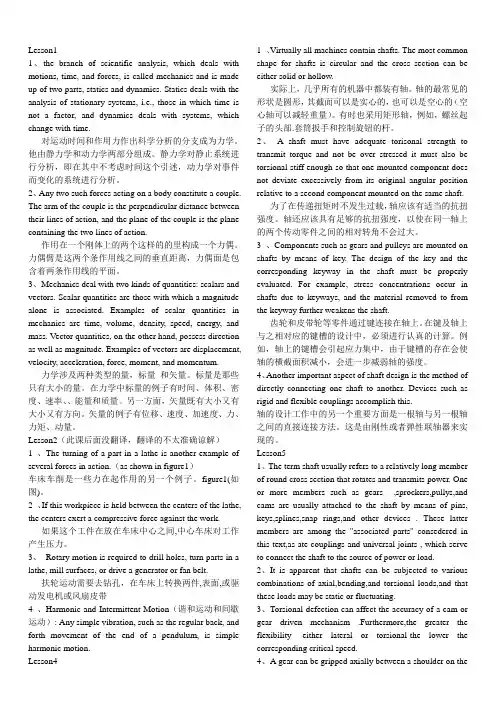
Lesson11、the branch of scientific analysis, which deals with motions, time, and forces, is called mechanics and is made up of two parts, statics and dynamics. Statics deals with the analysis of stationary systems, i.e., those in which time is not a factor, and dynamics deals with systems, which change with time.对运动时间和作用力作出科学分析的分支成为力学。
他由静力学和动力学两部分组成。
静力学对静止系统进行分析,即在其中不考虑时间这个引述,动力学对事件而变化的系统进行分析。
2、Any two such forces acting on a body constitute a couple. The arm of the couple is the perpendicular distance between their lines of action, and the plane of the couple is the plane containing the two lines of action.作用在一个刚体上的两个这样的的里构成一个力偶。
力偶臂是这两个条作用线之间的垂直距离,力偶面是包含着两条作用线的平面。
3、Mechanics deal with two kinds of quantities: scalars and vectors. Scalar quantities are those with which a magnitude alone is associated. Examples of scalar quantities in mechanics are time, volume, density, speed, energy, and mass. Vector quantities, on the other hand, possess direction as well as magnitude. Examples of vectors are displacement, velocity, acceleration, force, moment, and momentum.力学涉及两种类型的量,标量和矢量。

第九章Lapping 研磨Lapping is a finishing operation used on flat and cylindrical surfaces. The lap, shown in Fig.9.1a, is usually made of cast iron, copper, leather, or cloth.研磨是一种用于平面和圆柱面的精加工作业。
研具,如图9.1a所示,通常用铸铁、铜、皮革或布制成。
The abrasive particles are embedded in the lap, or they may be carried through slurry. Depending on the hardness of the workpiece, lapping pressures range from 7kPa to 140kPa (1 to 20 psi).研磨微粒嵌入研具内,或者可以通过液体携带。
根据工件硬度,研磨压力可在7kPa到140kPa(1到20psi)范围中取。
Lapping has two main functions. Firstly, it produces a superior surface finish with all machining marks being removed from the surface. Secondly, it is used as a method of obtaining very close fits between mating parts such as pistons and cylinders.研磨有两个主要作用。
首先,它通过去除所有机加工痕迹能产生较好的表面光洁度。
其次,它能用作获得像活塞与气缸之类配件间过盈配合的方法。
The lapped workpiece surface may look smooth but it is actually filled with microscopic peaks, valleys, scratches and pits. Few surfaces are perfectly flat. Lapping minimizes the surface irregularities, thereby increasing the available contact area.研磨后的工件表面可能看似平滑,其实布满着微观峰、谷、划痕和凹陷。

第一章:应力与应变1.That branch of scientific analysis which motions, times and forces is called mechanics and is made up of two parts, statics and dynamics.研究位移、时间和力运动乘力是科学分析法的一个分歧,被称作力学,力学由两大部分组成,静力学和动力学。
2.For example, if the force operating on a sleeve bearing becomes too high, it will squeeze out the oil film and cause metal-to-metal contact, overheating and rapid failure of the bearing.例如:如果止推轴承上的作用力过大的话,会挤出油膜,引起金属和金属之间的相互接触,轴承将过热而迅速失效。
3.Our intuitive concept of force includes such ideas as place of application, direction, and magnitude, and these are called the characteristics of a force.力的直观概念包括力的作用点、大小、方向,这些被称为力的三要素。
4.All bodies are either elastic or plastic and will be deformed if acted upon by forces. When the deformation of such bodies is small, they are frequently assumed to be rigid, i.e., incapable of deformation, in order to simplify the analysis.所有的物体既可以是弹性的也可以是塑性的,如果受到力的作用就产生变形。
![机械工程专业英语教程课文翻译[整理版]](https://uimg.taocdn.com/92f7af11e97101f69e3143323968011ca300f799.webp)
第三课Overview of Engineering Mechanics工程力学概述当我们观察我们周围就会发现世界充满“物品”:机器,设备,工具;我们已经设计,建造,并使用的物品;木头,金属,陶瓷和塑料制品。
根据我们使用的经验知道,有些物品比其它物品更好;他们使用寿命较长,费用较低,噪音更低,更好看,或者更方便我们使用。
然而,在理想的情况下,每一件产品都是设计人员工具其对某些“功能要求”的理解而设计出来的,也就是说,在设计过程中,应该回答这样的问题,即“它应该具有哪种确切的功能?”在工程领域,主要功能通常是承受由于重力,惯性力,压力等作用的一些类型的载荷。
从我们居住房屋的梁到飞机机翼,都必须有一个适当的材料,尺寸,在较合理的寿命基础上具有较合理的成本并能可靠地完成其功能的产品结构连接的组合。
在实践中,工程力学方法常被应用在两个完全不同领域:(1) 任何新装置的研发都需要对其结构,尺寸,材料,载荷,耐久性,安全和成本的反复考虑。
(2) 当一个装置(意外地)发生失效后,通常需要进行研究,找出失效的原因,并找出潜在的纠正措施。
最好的设计往往都是不断排除薄弱环节的演变过程。
对许多工程师来说,上述过程既可以令人非常的陶醉又可以使人非常的愉快,更何况(有时)对我们是有利的。
对于任何实际的问题,总是缺乏足够完整和有用的信息。
我们很少准确地知道实际荷载和工作状态,因此,所做的分析工作也很少是精确的。
虽然我们的数学可以准确,全面的分析一般只能近似,而且不同技术水平的人能得到不同的解。
在工程力学研究领域,大多数问题要想得到唯一解就要充分的理想化,但应该清楚,“现实世界”远不非理想化程度,因此为了得到问题的解决方案不得不进行一些理想化假设。
我们要考虑的技术领域通常被称为“静力学”和“材料力学”,“静力学”,指的是研究作用在固定装置上的作用力,“材料力学”指的是施加到结构的力(变形,载荷限制等)的影响。
但是,事实上很多设备都不是静态的,如果与动力学有关的额外负荷被考虑了的话,那么静力学的研究方法完全适用于动态的情况,只要动态力相对静态载荷较小,系统通常被认为是静态的。
![机械工程专业英语-007[10P][203KB]](https://uimg.taocdn.com/0362fedeb14e852458fb57be.webp)
机械工程专业英语》参考译文高等学校机械设计制造及其自动化专业新编系列教材(供教师及学生使用)黄运尧黄威司徒忠李翠琼武汉理工大学出版社目录编译者的话………………………………第1章材料和热加工…………………第1课机械学的基本概念…………第2课塑性理论的基本假设………第3课有限元优化的应用…………第4课金属…………………………第5课金属和非金属材料…………第6课塑料和其他材料……………第7课模具的寿命和失效…………第8踩冷加工和热加工……………第9踩铸造…………………………第10课制造中的金属成形工艺…第11课缎选………………………第12课锻造的优点和工作原理…第13课焊接………………………第14课热处理……………………第二章机构和机器原理……………。
第15课机构介绍…………………。
第16课运动分析………………….第l7课运动的综合………………—第18课凸轮和齿轮………………—第19课螺纹件,紧固件和联接件—第20课减(耐)摩擦轴承…………*第2l课斜齿轮、蜗杆蜗轮和锥齿轮第22课轴、离合器和制动器……—第三章机床………第23课机床基础第24课车床……第25课牛头刨、钻床和铣床…………第36课磨床和特种金属加工工艺……第四章切削技术和液压“………………第27课加工基础………………………第28课基本的机械加工参数…………第29课切削参数的改变对温度的影响第30课刀具的磨损…………第31课表面稍整加工机理…第32课极限和公差…………“第33课尺寸控制和表面桔整”第34课自动央具设计………“第36课变速液压装置……………—…………—策37课电液伺服系统…………。
……………。
第五章机械电子技术………………………………第38课专家系统……。
…………………………第3D课建筑机器人………………………………第40课微机为基础的机器人模拟………………第41课机器人学的定义和机器入系统…………第42课微型计算机基础(1)……………………第43课微型计算机基础(x)……………………第44课可编程控制器……………………………第45课CAD/CAM计算机辅助设计与制造…第46课计算机数控和直接数控,CNC和DNC第47课加工过程的数控—………………………第48课柔性制造系统……………—……………第仍课交互式编程系统…………………………第50课在振动分析方面的计算机技术…………策51课压力传感器………………………………第52课反馈元件…………………—……………第53课现代按制理论概述………………………第54课管理上采取了新的措施—来自福持汽第六章英文科技文献和专利文献的查阅…………6.1 常见科技文献及其查阅………………………6.2 专利文献概述…………………………………第七章英文科拉论文写作…………………………7.1 标题与摘要写法………………………………7.2 正文(body)的组织与写法…………………7.3 致谢、附录及参考文献………………—……参考文献………………………………………………第1章材料和热加工机械学的基本概念功是力乘以该力作用在物体上佼物体移动的距离。
Types of Materials材料的类型Materials may be grouped in several ways. Scientists often classify materials by their state: solid, liquid, or gas. They also separate them into organic (once living) and inorganic (never living) materials.材料可以按多种方法分类。
科学家常根据状态将材料分为:固体、液体或气体。
他们也把材料分为有机材料(曾经有生命的)和无机材料(从未有生命的)。
For industrial purposes, materials are divided into engineering materials or nonengineering materials. Engineering materials are those used in manufacture and become parts of products.就工业效用而言,材料被分为工程材料和非工程材料。
那些用于加工制造并成为产品组成部分的就是工程材料。
Nonengineering materials are the chemicals, fuels, lubricants, and other materials used in the manufacturing process, which do not become part of the product.非工程材料则是化学品、燃料、润滑剂以及其它用于加工制造过程但不成为产品组成部分的材料。
Engineering materials may be further subdivided into: ①Metal ②Ceramics ③Composite ④Polymers, etc.工程材料还能进一步细分为:①金属材料②陶瓷材料③复合材料④聚合材料,等等。
Unit 14Limits and Tolerances1.Dimensioning2.Dimension and Tolerance3.Tolerances Limits and Fits4.Type of Limits and Fits1.DimensioningTolerances must be placedon the dimensions of a drawing to limit the permissiblevariations in size because it isimpossible to manufacture apart exactly to a givendimension. Although smalltolerances give higher qualitywork and a better operatingmechanism, the cost ofmanufacture increases rapidlyas the tolerances are reduce,as indicated by the typical curve of Fig.1.Fig.1 Relationship between size of tolerance and cost of production2. Dimension and ToleranceTolerance is the amount of variation permitted in the part or the total variation allowed in a given dimension.Tolerances may be either unilateral[单边的] or bilateral [双边的].Unilateral tolerance means that any variation is made in only one direction from the nominal or basic dimension.0.0030.0001.500+-Bilateral tolerance meansthat the tolerance would vary both over and under the nominal dimension.1.5000.003±3. Tolerances Limits and FitsA tolerance is the difference in a dimension in order toallow for unavoidable imperfections in workmanship. Thetolerance range will depend on :●the accuracy of the manufacturing organisation [组织]●the machining process●the magnitude of the dimensionLimits are the extreme dimensions of the tolerance zone.For example, nominal dimension30 mm tolerance 30.02530.000++limits 30.02530.000Fits depend on the relationship between the tolerance zones of two mating parts, and may be broadly classified into a clearance fit with positive allowance, a transition fit where the allowance may be either positive or negative (clearance or interference), an interference fit where the allowance is always negative.4. Type of Limits and FitsThere are three classes of fits:1)clearance fits2)transition fits3)interference fitsThe tolerance is a function of the basic size and is designated by a number symbol, called the grade —thus the tolerance grade.Twenty standard grades of tolerances are provide, called IT 01, IT 0, IT 1-18, providing numerical values for each nominal diameter, in arbitrary steps up to 500 mm(for example 0-3, 3-6, 6-10, …, 400-500 mm).Clearance FitA clearance fit is one having limits of size defined suchthat a clearance always results when mating parts areassembled.Transition FitA transition fit is one having limits of size so prescribed [规定]that either a clearance or an interference mat result when mating parts as assembled.Interference FitAn interference fit is one having limits of size soprescribed that an interference always results when matingparts are assembled.。
机械工程专业Mechanical Engineering Major一、专业介绍Ⅰ. Major Introduction本专业培养适应社会主义现代化和地方及区域经济建设需要,在工程意识、技术素养、实践能力、创新精神与思想道德、艺术文化、人文精神等方面全面和谐发展,具备机械工程专业基础知识与应用能力,能在企业生产一线从事机械、机电产品的开发、设计、制造以及生产运行与设备控制的应用型、复合型、创新型高级工程技术人才。
This major aims at cultivating advanced engineering and technology-oriented talents who will have the ability of application, compound and innovation. The graduates shall achieve the following specific standards: adapting to the socialist modernization and the local and regional economic development; with engineering consciousness, technology literacy, practice ability, innovation spirit and morality, art and culture, humanistic spirit and other aspects of a comprehensive and harmonious development; with the professional basic knowledge and application ability of mechanical engineering; working on the mechanical and electrical products for the development, design, manufacture, operation and equipment control in the production company.二、教学计划注:表中“/”号后为教学计划内课外学时。